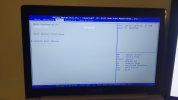Jerry-Linux
New Member
Linux Noob here.
I am trying to install Linux Mint 21.1, Cinnamon Edition on my older ASUS Zenbook N501JW laptop. After I load and install Linux Mint via USB my laptop boots straight to BIOS. Every time.
The process I have followed thus far:
Prep for Install
Installation process
After Installation and reboot my ASUS laptop goes straight to BIOS.
Troubleshooting
I am able to put the NVMe drive into a modern desktop computer and Linux boots fine, so the problem seems to point to the ASUS laptop.
When I place the USB drive back in and load Linux Live and load "Boot Repair" and click "Recommended repair" I get the following error: "Error: NVram is locked (Linuxmint not found in efibootmgr)."
I have updated my BIOS. I have disconnected my laptop battery and the small watch-type battery from the ASUS laptop in order to reset the BIOS.
Unfortunately, I cannot get past the BIOS in my ASUS laptop.
Any help or ideas would be appreciated.
(Attached is the boot info document for the error I get)
I am trying to install Linux Mint 21.1, Cinnamon Edition on my older ASUS Zenbook N501JW laptop. After I load and install Linux Mint via USB my laptop boots straight to BIOS. Every time.
The process I have followed thus far:
Prep for Install
- I have a brand new NVMe drive installed in the ASUS laptop
- I have disabled "Secure Boot" in BIOS.
Installation process
- I used RUFUS 4.0 to create a bootable version of Linux Mint 21.1 on a USB Drive.
- I have tried both Partition Schemes of MBR and GPT. But in the current version I am trying MBR.
- In my BIOS I have disabled "Secure Boot"
- I connect my USB drive in my ASUS laptop and boot to the GNU GRUB --> and click Start Linux Mint 21.1 Cinnamon 64-bit
- I double click "Install Linux Mint" --> "Erase disk and install Linux Mint"
After Installation and reboot my ASUS laptop goes straight to BIOS.
Troubleshooting
I am able to put the NVMe drive into a modern desktop computer and Linux boots fine, so the problem seems to point to the ASUS laptop.
When I place the USB drive back in and load Linux Live and load "Boot Repair" and click "Recommended repair" I get the following error: "Error: NVram is locked (Linuxmint not found in efibootmgr)."
I have updated my BIOS. I have disconnected my laptop battery and the small watch-type battery from the ASUS laptop in order to reset the BIOS.
Unfortunately, I cannot get past the BIOS in my ASUS laptop.
Any help or ideas would be appreciated.
(Attached is the boot info document for the error I get)








